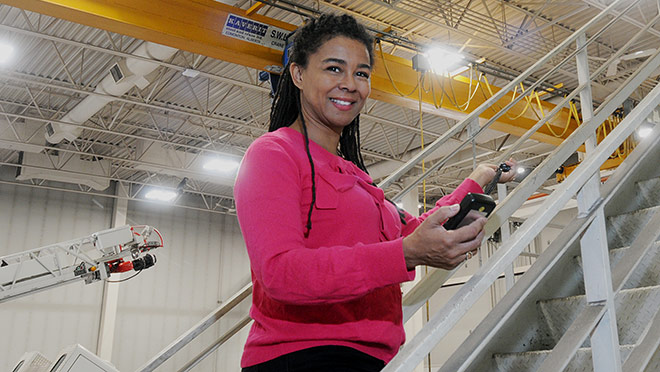Energy is baked into asset plan at District of North Vancouver

'Every time we touch a building, we know we're improving efficiency'
The perils of a building not optimized for energy management became clear to Monica Samuda on her first day of work with the District of North Vancouver in 2014.
"It was January 27 when I walked into the district hall, and the chiller was running at 8 a.m. ," recalls Samuda, who is the district's energy manager. "On a cold day when it was snowing, there was steam coming out of the cooling tower. I knew there was energy to be saved because there was nothing telling the chiller it wasn't needed – it just turned on."
That chiller became emblematic of what needed to change in the district. Here was a beautiful new district hall – built in 1997 and featuring an airy atrium of glass, metal and beech wood – with an outdated and oversized chiller that ran constantly to use far more energy than necessary. Samuda set out with the goal of ensuring that no work on any building in the district, new or existing, would be done without careful consideration of energy efficiency.
"The understanding is that anytime we touch a building, we're improving efficiency," says Samuda.
It's paying off with a change in culture and processes that have helped target and deliver significant energy use and GHG reductions in key district buildings. Electricity use in the district's municipal hall dropped 31% between 2011 and 2019, and natural gas use plummeted by 49% for overall GHG emission reductions of 50%.
Energy management has also helped the district minimize risks. When an Enbridge gas pipeline explosion in October of 2018 caused spikes in natural gas prices in B.C., buildings in the district with good energy management controls in place were able to reduce energy use and avoid a big chunk of additional costs.

Dozens of buildings needed work, but five use the bulk of energy
A native of Manitoba, Samuda honed her skills as an energy manager with the City of Winnipeg and then the City of Vancouver before landing the job in North Vancouver in 2014. Early on, she became a huge fan of BC Hydro's energy manager program in which the utility helps co-fund, trains them and provides ongoing resources and support for what has become a vital position at large B.C. organizations.
"With the energy manager model that's been replicated over and over again here in B.C., people come to trust it," she says. "In North Vancouver, there's been an energy manager since 2009, and that makes an important difference."
Energy managers all have different approaches to small and large projects or specific technologies. For example, one focus in the District of North Vancouver has been district energy, a proposed thermal energy distribution system that may someday provide heating energy (and in some cases cooling energy) to connected buildings in a community where an estimated 50% of total greenhouse gas emissions are produced by buildings.
Samuda's approach was different. She wanted to zero in on efficiencies and savings in existing district buildings, and to take on the big energy users first.
"Four buildings, and now five, represent more than half of the number of total emissions and energy use in the district," she says. "The district was trying to show they had projects that should be done in every district building, but I told them you have five that are making all the difference. We could decrease energy use in 80% of all the other buildings, but we'd still be left with most our emissions if we don't tackle these five buildings."
Factoring in all buildings it operates, the district's gas use in 2019 compared to 2011 was down 29%, its electricity use was reduced 8% despite a series of initiatives to switch from gas to electric, and its greenhouse gases were down a whopping 31%.
BC Hydro key account manager Victoria Richards, who has worked with Samuda for years, applauds Samuda's strategy of targeting older buildings to produce energy savings.
"Just because a building's older doesn't mean you can't make it more efficient," says Richards. "Some of the most exciting and interesting things Monica has done is in older buildings like Karen Magnussen Community Recreation Centre.
"Some people may write off savings potential in older buildings and wait until they're replaced, but she doesn't do that."
Upgrades at Karen Magnussen – including lighting, heat recovery, and efficiency upgrades to the wave generator in the centre's pool – have delivered energy savings and a projected 60% reduction in greenhouse gas emissions. Richards says the GHG reduction helped make it possible for the district to build the beautiful new Delbrook Community Recreation Centre without compromising their district-wide carbon emission targets.
"Communities like North Vancouver are growing, but you can bring on a new building without actually increasing your GHG emissions if you can reduce the emissions in an older building," says Richards.
Upgrades piggybacked on existing projects
Samuda is supported by facilities and finance departments fully convinced of the enormous cost of operating and maintaining municipal assets over time, and how big a role energy has to play.
"That was a huge fight I didn't have to have... that I did need to fight at other places I've worked," she said. "The organization understood that in the facilities department, energy had an immediate role right alongside other initiatives. As maintenance and operations plans were formalized, energy was always there. It wasn't at the end of the list of tasks, it was at the top."
On the list of recent projects are the addition of building automation systems in two of the largest buildings, including the district hall (the one with the big chiller) built in 1997. But automation came in baby steps, starting with a creative solution by maintenance coordinator Ian Leviton.
Like so many buildings built in that era, the district hall's systems were running pretty much 24 hours a day from 1997 to 2012. Leviton devised a way to use an existing project – the introduction of automated door locks that governed the hall's opening and closing each day – to introduce system shutoffs.
"He used some rudimentary but really brilliant ideas to cut power to all the systems in the building when the doors lock and unlock, at 6 p.m. or 9 p.m.," says Samuda. "If you were in the building you would be able to hear every system shift off. I was never in the building at 6 a.m. but when it started up again, you can imagine what it would be like as every system, including the chiller, the air handlers, every fan, just all came on at once."
Samuda adds that, for reasons that remain a mystery, the chiller installed in the district hall is about 10 times the size it needs to be. She says that so much cold water was being produced by the chiller that the building's boilers would kick in to warm up areas the chiller was overcooling. New controls now limit wasted energy used by the chiller, but it's still oversized, so the district is exploring a heat recovery option that could be a chiller replacement right-sized for the building's needs.
"Our building is two and a half storeys, but if you walked into our mechanical room, you'd think it was 12 storeys," she says. "We had two massive boilers, hot water tanks all over the building, and this giant chiller."
Today, the building uses three smaller high-efficiency condensing boilers, and proper controls have been introduced. Gas use in the hall is down 49% from 2011, electricity use is down 31%, and GHG emissions have been reduced 50%.
A word of warning: Don't freeze the big boss
One of the ironies of the district's strategy of piggybacking energy work on existing projects is that most people are often unaware of all the great work that's being done.
When the Karen Magnussen Recreation Centre and Pool – one of the big five district buildings – was upgraded with a heat recovery system with the potential to reduce gas heating costs by 80%, the work was done as part of regular maintenance. Samuda says the centre never needed to be closed for the work, and water to the pool was turned off for one night.
But there are exceptions. Back at the district hall, when automatic HVAC controls were first introduced to council chambers, council was unfortunately in session one evening before the controls had been tuned. There was a glitch in the cooling system, and the district's chief administrative officer happened to be sitting in the chilliest part of the room.
"He was not a fan of the controls," says Samuda, with a laugh. "We accidentally froze the CAO, which is a terrible way to introduce someone to a new system."
Learn more about how strategic energy management can benefit your organization.